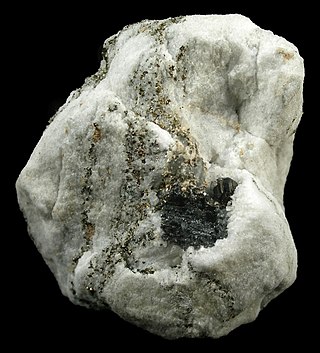Top Qs
Timeline
Chat
Perspective
Sartorite
Lead arsenic sulfide From Wikipedia, the free encyclopedia
Remove ads
Sartorite is a lead arsenic sulfide with the chemical formula PbAs2S4 and as type locality the Lengenbach Quarry in Legenbach, Binnental, Valais, Switzerland.[2][3] Historically, sartorite has been thought isomorphic to chalcostibite, emplectite, and zinckenite, but was definitively distinguished from the others in 1939.[4]
Remove ads
Etymology
The mineral is named after its discoverer, Sartorius von Walterhausen (1809-1876).[5]
Occurrences
The mineral is predominantly found in hydrothermal deposits in dolomite. Sometimes the mineral is containing traces of thallium and has been reported from:[2]
- Argentina
- Jujuy Province
- Rinconada Department
- Rinconada
- Cerro Redondo prospect
- Rinconada
- Rinconada Department
- Jujuy Province
- Austria
- Tyrol
- North Tyrol
- Hall
- Hall valley
- Salt mine
- Hall valley
- Tyrol
- Azerbaijan
- Balakan District
- Belokan-Avar ore district
- Filizchai deposit
- Belokan-Avar ore district
- Balakan District
- China
- Hungary
- Italy
- Tuscany
- Lucca Province
- Seravezza
- Seravezza quarrying basin
- Seravezza
- Lucca Province
- Tuscany
- Japan
- Hokkaidō
- Abuta District
- Takarada
- Tohya mine (Toya mine; Tohya-Takarada mine) ?
- Takarada
- Abuta District
- Hokkaidō
- Spain
- Andalusia
- Granada
- Baza
- Sierra de Baza
- Calar de San José
- Sierra de Baza
- Baza
- Granada
- Andalusia
- Switzerland
- United States
- Colorado
- San Juan Co.
- Red Mountain Mining District
- Anvil Mountain
- Zuñi mine
- Anvil Mountain
- Red Mountain Mining District
- San Juan Co.
- New York
- St. Lawrence Co.
- Fowler
- Sylvia Lake
- Balmat mine
- Sylvia Lake
- Fowler
- St. Lawrence Co.
- Colorado
Remove ads
See also
References
Further reading
Wikiwand - on
Seamless Wikipedia browsing. On steroids.
Remove ads

